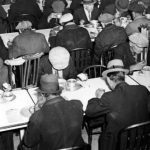 Technology
Technology  Technology
Technology  Humans
Humans 10 Everyday Human Behaviors That Are Actually Survival Instincts
 Animals
Animals 10 Animals That Humiliated and Harmed Historical Leaders
 History
History 10 Most Influential Protests in Modern History
 Creepy
Creepy 10 More Representations of Death from Myth, Legend, and Folktale
 Technology
Technology 10 Scientific Breakthroughs of 2025 That’ll Change Everything
 Our World
Our World 10 Ways Icelandic Culture Makes Other Countries Look Boring
 Misconceptions
Misconceptions 10 Common Misconceptions About the Victorian Era
 Mysteries
Mysteries 10 Strange Unexplained Mysteries of 2025
 Miscellaneous
Miscellaneous 10 of History’s Most Bell-Ringing Finishing Moves
 Technology
Technology Top 10 Everyday Tech Buzzwords That Hide a Darker Past
 Humans
Humans 10 Everyday Human Behaviors That Are Actually Survival Instincts
 Animals
Animals 10 Animals That Humiliated and Harmed Historical Leaders
Who's Behind Listverse?

Jamie Frater
Head Editor
Jamie founded Listverse due to an insatiable desire to share fascinating, obscure, and bizarre facts. He has been a guest speaker on numerous national radio and television stations and is a five time published author.
More About Us History
History 10 Most Influential Protests in Modern History
 Creepy
Creepy 10 More Representations of Death from Myth, Legend, and Folktale
 Technology
Technology 10 Scientific Breakthroughs of 2025 That’ll Change Everything
 Our World
Our World 10 Ways Icelandic Culture Makes Other Countries Look Boring
 Misconceptions
Misconceptions 10 Common Misconceptions About the Victorian Era
 Mysteries
Mysteries 10 Strange Unexplained Mysteries of 2025
 Miscellaneous
Miscellaneous 10 of History’s Most Bell-Ringing Finishing Moves
10 Weird Distractions from the Great Depression
The Great Depression was one of the darkest chapters in American history. Millions of people lost jobs, homes, and savings; breadlines and shuttered factories became part of daily life. Yet even in that bleak decade, the human spirit refused to break. Families found creative, inexpensive ways to laugh, play, and connect.
From homemade haunted houses and penny-movie matinees to bizarre contests like goldfish swallowing, Americans improvised a sense of joy amid hardship. These moments of levity didn’t erase the pain of the 1930s—but for a while, they made life feel a little more normal.
Related: Top 10 Surprising Ways Average Joes Survived the Great Depression
10 Hallowed Haunted Haunts
There aren’t too many things cheaper for a family to put together for children than a haunted house. Hang a few creepy streamers and sheets, put Dad in a white bed sheet with eyes cut out as a “ghost,” turn off all the lights, light a few candles—and boom! Your average seven-year-old is ready to be horrified. That seems to be one way to celebrate Halloween today, at least for now. And that was pretty much the thought process during Depression-era Halloweens, too.
Halloween had long been a night for trickery around the United States. Even before the Great Depression, teens and children loved to go around causing mayhem and creating innocent mischief in neighborhoods across the country.
But in October 1933, at one of the lowest points of the Depression, thousands of teenage boys all over the country took their mischief to the next level. Cars were flipped over, telephone poles and street signs were destroyed, and dozens of communities around the U.S. woke up on November 1 to the aftermath of real, actual mayhem.
That didn’t sit well with people who were already struggling to keep it together during the economic crash. So families and community leaders alike banded together in enclaves across the nation to start offering more specific and guided Halloween options for kids. Chief among those was the haunted house!
Pamphlets and brochures counseled families and local leaders on how to put together a properly spooky attraction. And the next year, in 1934, the advice stuck. Ever since then, haunted houses have been a Halloween staple—and it all began as a Depression-era community solution.[1]
9 Movies Make Moves
The Great Depression was brutal on nearly all American businesses and industries—except for Hollywood. Movie tickets cost less than a quarter for most of the 1930s, making spending time in the theater cheap and easy. More than money, though, the films shown in that decade served as an escape from a tough time. The film industry had only just gone from silent pictures to “talkies,” and along with that development, Hollywood invested heavily in new production technology.
Then all that investment paid off as major motion pictures landed in theaters throughout the decade. Rapt audiences tuned in for blockbusters like Snow White and the Seven Dwarfs (1937), 42nd Street (1933), and The Wizard of Oz (1939). Viewers were enamored of the amazing art on screen, and the images lingered in their minds for days afterward. Because tickets were so cheap, many people could go back again and again to get their fill. In an economic era when most industries cratered, Hollywood boomed.
Escapism was a big part of Hollywood’s success, too. Not only were Depression-era families seeking diversion from their weary weeks, but the ability to get lost in a fun or dazzling movie mattered. Screwball comedies blew up big in the 1930s, with everything from Marx Brothers–inspired farce to rom-coms starring Katharine Hepburn and Cary Grant.
Viewers imagined themselves living alongside stars like Marlene Dietrich and Barbara Stanwyck. The downtrodden Average Joe would never make it to that level, of course, but the ability to escape there for a few hours proved irresistible.[2]
8 Reading About the Rich
For as long as American pop culture has existed, the public has loved reading about the lives of the rich and famous. That didn’t change during the Great Depression. In fact, the economic downturn proved the perfect time for Americans to indulge in gossip and salacious celebrity stories. The celebrity-gossip era really took off after Prohibition ended in 1933.
Former speakeasies in places like New York City quickly transformed into high-end nightclubs. Movie stars, musicians, and moguls who hadn’t lost their fortunes filled the places nightly. Soon enough, plenty of gossip columnists were there, too, and they reported on everything (with a few embellishments, of course) to newspaper readers waiting at home.
It wasn’t just nightclub culture that took off during the Depression. Stuck at home and often with little to do, lower- and middle-class Americans devoured stories about rich-person dramas. Chief among them were legal cases involving society’s elite. Take, for example, the 1934 custody trial over ten-year-old heiress Gloria Vanderbilt. As her parents fought for their rights in court, newspapers jumped all over the story. They called Gloria the “poor little rich girl” and followed the trial endlessly.
That moniker was soon handed to other wealthy young women, including Barbara Hutton, the heiress to the Woolworth fortune. Whether out of spite or aspirational curiosity, readers flocked to these stories about the richest, most out-of-touch Americans. Come to think of it, that’s not so different from the celebrity-gossip industry today.[3]
7 Making Monopoly Moves
While movies and celebrity gossip were popular diversions during America’s toughest economic era, board games also proved to be a major source of cheap, easy, and repeatable fun. Way back in 1904, a woman named Elizabeth J. Magie invented and patented a board game called “The Landlord’s Game.” She intended it to teach the evils of capitalism and rent-seeking. But three decades later, that lesson would flip on its head, becoming a game we still know and love today.
In the early 1930s, a man named Charles Darrow brought a new version of Magie’s idea to the Parker Brothers toy company. The Parkers had been struggling to stay afloat during the Depression, but Darrow thought he had the perfect hit. He pitched them a game based closely on Magie’s original invention, called “Monopoly.” He sold it so well that Parker Brothers agreed to buy it in 1935.
Almost immediately, Monopoly became a huge hit. It was cheap, endlessly reusable, and provided hours of family entertainment. For households with tight budgets, gathering around the table to play was an affordable luxury. It also became a form of wish fulfillment for struggling families: they bought hotels, collected rent, and lived “lavishly” as they circled the board—dreaming of a prosperity they knew they’d never reach.[4]
6 Dance ‘Til You Drop—Literally
Dance marathons weren’t just a Depression-era phenomenon; they actually began a few years earlier, in the Roaring Twenties. But as the stock market crashed, Americans’ desire to watch people dance for hours on end only increased. And while these marathons rarely paid much money, the winnings could be life-changing as jobs became scarce.
Depression-era dance marathons often lasted for days at a time. Dancers were given food, which they had to eat standing up at chest-high tables brought onto the dance floor. They were typically granted a ten- or fifteen-minute break every hour. During that time, they could lie down on a cot or have a nurse rub their sore feet. But before they knew it, they were up again—and the dancing continued through the night… and the next day… and the night after that.
Quickly, dancers learned to sleep in shifts. One partner would do the heavy lifting (literally) and hold the other upright while the slumbering contestant caught a brief catnap. They didn’t want to risk collapsing mid-snooze, so dancers often tied their hands around their partners’ necks to stay vertical.
As you might expect, these marathons were dangerous. Asking people to stay on their feet for days with only a few minutes of low-quality rest was a recipe for exhaustion and injury. That danger was part of the appeal: spectators flocked to watch contestants push themselves to the brink for a shot at the prize money. By the late 1930s, though, public opinion soured. Outcry over the cruelty led many cities to ban the contests outright. By the eve of World War II, the dance-marathon craze had faded away.[5]
5 Following the Funnies
Newspaper cartoons have a long history in America. Long before the Great Depression, political cartoons lampooned civic leaders and public figures. But it was during the 1930s downturn that cartoon fun really took off—and these new strips were mostly aimed at children. Every Sunday, kids across the nation reached for the funny pages to follow Dick Tracy, Little Orphan Annie, Little Lulu, Flash Gordon, and many more.
The kids’ cartoons didn’t come without controversy, though. Little Orphan Annie was both beloved and reviled. Its creator, cartoonist Harold Gray, launched the strip in the 1920s when the economy was booming, and the syndication made him wealthy. With the Roaring Twenties in full swing, Annie often aligned with pro-business ideals. For a while, that was fine—or at least ignored by adults as kids enjoyed the adventures.
After the Depression hit in 1929, however, Gray’s politics grew more pronounced. When FDR was elected in 1932, Gray began using the strip to criticize the president’s New Deal policies and labor unions. In turn, political critics attacked Gray for promoting right-wing ideas, with one magazine famously calling Annie “fascism in the funnies.” Thus, even during hard times, children’s comics could spark grown-up controversy.[6]
4 Goldfish Swallowing
By the tail end of the Great Depression, in 1939, you’d think people would be ready to move on from frivolous diversions and, say, read a book. But no—you’d be wrong! That spring, a few Harvard University students got into a debate over supposed feats they could accomplish.
A couple of upperclassmen offered a freshman a $10 bet: he had to swallow a goldfish. On March 3, with dozens of students and a newspaper reporter watching in the dining hall, the student actually chewed up and swallowed the live fish. He won the $10—but more importantly, he started a short-lived and very strange trend: goldfish swallowing.
Soon after, LIFE Magazine picked up the story. As it went national in that era’s version of “viral” fame, college students, high school kids, and curious thrill-seekers everywhere tried it. Within weeks, swallowing one goldfish wasn’t impressive anymore. By late April, the “record” stood at 42 fish—appropriately consumed by a member of the Class of 1942—and soon it climbed into triple digits. The craze was completely out of control, and people across the country loved to watch it unfold.
People started swallowing other creatures, too. Some students downed baby white mice; others tried angleworms, magazines, or even shards of phonograph records. Soon enough, the bizarre goldfish challenge morphed into what might be considered that era’s equivalent of the Tide Pod Challenge.
Thankfully, those other trends didn’t catch on—and, mercifully for goldfish everywhere, the original fad fizzled out by 1940. Then World War II arrived, and college students suddenly had much bigger problems.[7]
3 Radio Ruled the Roost
Television wasn’t yet a thing during the Great Depression, but the 1930s saw radio’s popularity explode. At the start of the decade, fewer than half of American households owned a radio. By the end of the 1930s, that number had soared to nearly 90%, and soon, car radios were common too.
Radio became a vital source of both news and entertainment for Depression-era families. Kids crowded around to hear The Lone Ranger and The Green Hornet. Comic-strip heroes like Dick Tracy and Little Orphan Annie crossed over to the airwaves, while comedians George Burns and Gracie Allen enjoyed nationwide fame. Even the problematic Amos ‘n’ Andy—a product of the time’s racial stereotypes—reached its peak audience in the 1930s.
Radio was also a crucial news medium. Families desperate for information tuned in for updates about jobs, weather, and world events. President Franklin D. Roosevelt used the platform masterfully, beginning his famous “fireside chats” on March 12, 1933. His calm, conversational tone helped reassure Americans through banking crises, the Dust Bowl, and the early New Deal years. For many, his voice became a source of comfort in uncertain times.[8]
2 Soap Box Derby Days
Today, the Soap Box Derby feels like a piece of 1950s nostalgia, but the sport actually began during the Great Depression. In 1933, journalist Myron Scott of Dayton, Ohio, noticed kids racing homemade cars built from wooden soap boxes and spare parts. They sped down hilly streets, laughing all the way. Seeing a story, Scott snapped photos for his paper—and an American tradition was born.
Soon, Dayton fell in love with the races. Scott helped organize bigger and better competitions, and by the end of the summer, the pastime had spread nationwide. Some races drew thousands of spectators to watch local kids hurtle downhill in rickety homemade cars.
In 1934, Scott partnered with Chevrolet to sponsor the first All-American Soap Box Derby. Only boys were allowed to compete—girls wouldn’t be admitted until 1971—but the event was an instant hit. Regional winners traveled to Dayton for the championship, which moved to Akron the next year, where it remains today. Born from Depression-era ingenuity, the derby offered excitement for racers and families alike.[9]
1 Flagpole Sitting
If you thought dance-marathon viewing was odd, this one takes it higher—literally. Another 1920s endurance stunt that carried over into the 1930s was flagpole sitting. Hollywood stuntman Alvin “Shipwreck” Kelly is credited with starting the craze a few years before the Depression, and soon it was everywhere.
In the summer of 1930, Kelly sat atop a 225-foot (69-meter) flagpole in Atlantic City, New Jersey, for 49 days—eating, shaving, and sleeping high above the boardwalk.
His feat inspired imitators nationwide. Some climbed poles to prove their endurance or earn small cash prizes; others, like Kelly, treated it as performance art. Crowds gathered daily to watch the sitters perched above the street. Most poles were shorter than Kelly’s, thankfully, but the fad became a well-known Depression-era diversion—and it didn’t cost a dime to spectate.
Middle America had its own version, too: tree-sitting. Across the summers of 1930 and 1931, boys and teenagers across the country spent hours or even days in trees while friends cheered and jeered from below. It might not sound like much fun today, but for restless Depression-era youth, it was cheap entertainment and a brief escape from hard times.[10]








